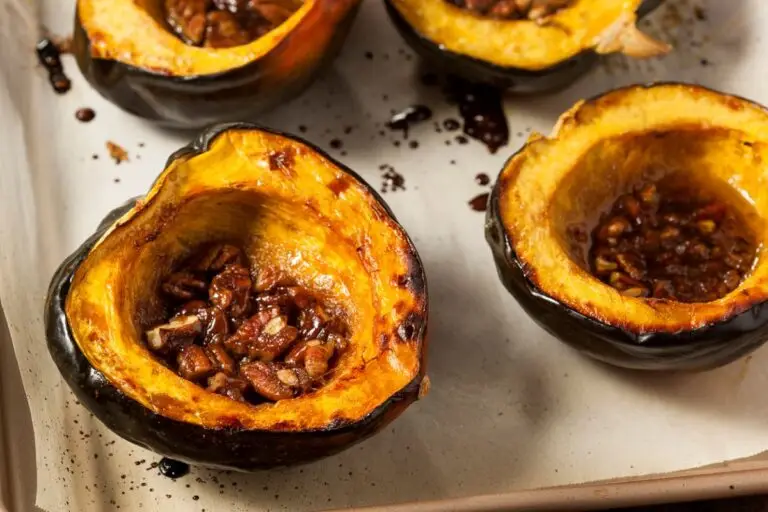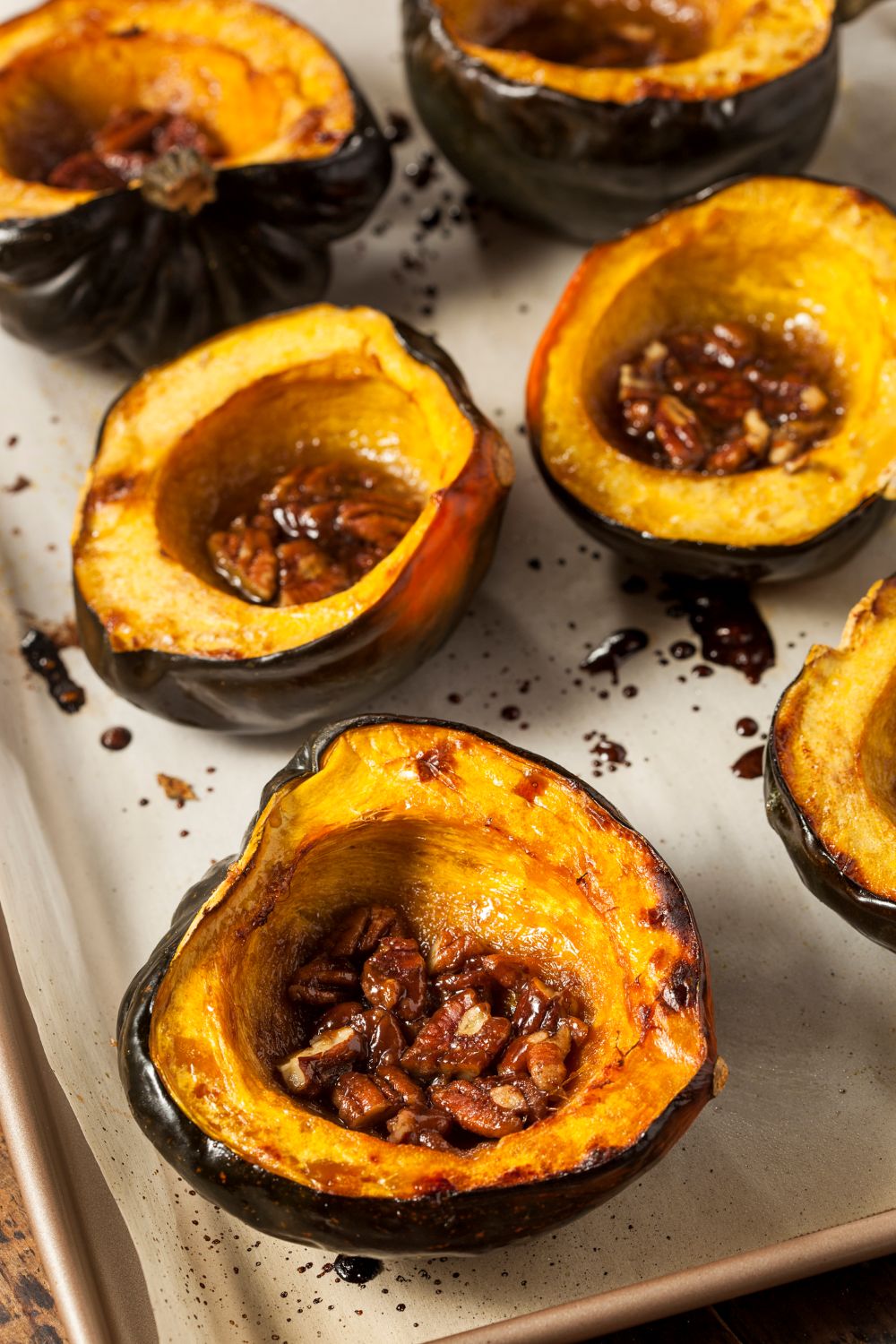This classic baked acorn squash with butter and cinnamon delivers tender, caramelized perfection in just one hour using only six simple pantry ingredients. The steaming method produces a more tender flesh than modern roasting techniques, while the butter-cinnamon filling creates a sweet glaze that pools in the center.
This vintage recipe is so simple - no fancy equipment needed, just some basic pantry staples and your oven.
The sweet fragrance of cinnamon and butter fills the kitchen as the squash halves transform from a pale yellow to a deep golden hue. The buttery pool in the center, studded with whole cloves, tastes exactly as autumn should: warm, comforting, and slightly spiced. When you scoop through that tender flesh, each bite carries hints of maple sweetness balanced by a whisper of pepper.
The 1949 Kitchen
In 1949, home cooks were finding their rhythm again after years of wartime rationing. Victory gardens were still flourishing in backyards, and families were eager to celebrate the harvest season with vegetables they'd grown themselves. Winter squash, like acorn, became a staple because it stored nicely in cool cellars for months without refrigeration.
The typical 1949 kitchen featured an electric or gas oven that could hold a steady temperature, a significant upgrade from coal or wood-burning stoves. Radio programs like "The Betty Crocker Cooking School of the Air" shared recipes with millions of housewives tuning in mid-morning. Acorn squash recipes were often shared during these broadcasts because they stretched the food budget while providing hearty, nutritious side dishes for growing families.
Whole cloves appeared frequently in 1940s recipes, adding aromatic warmth to both sweet and savory dishes. These tiny flavor powerhouses were affordable pantry staples that elevated simple vegetables into something special for Sunday suppers and holiday tables.
What Makes This Baked Acorn Squash Recipe Work

Baked Acorn Squash Recipe
This classic baked acorn squash with butter and cinnamon is a vintage 1949 recipe that produces tender, caramelized squash with a sweet, spiced glaze. Simple pantry ingredients and a unique steaming technique create restaurant-quality results that taste like pure autumn comfort.
- Total Time: 1 hour 10 minutes
- Yield: 6 servings 1x
Ingredients
- 3 medium acorn squash
- 3/4 teaspoon salt 3/8 teaspoon black pepper
- 3/4 teaspoon ground cinnamon
- 6 whole cloves
- 6 tablespoons molasses (or substitute maple syrup/brown sugar)
- 6 tablespoons butter or margarine
Instructions
- Prepare oven and pan: Preheat oven to 400°F. Add 2 inches of hot water to a large baking pan.
- Prepare squash: Wash acorn squash thoroughly. Cut each squash in half lengthwise using a sharp knife. Scoop out seeds and stringy pulp with a spoon, discarding them.
- Season squash: Sprinkle the inside of each squash half with salt, pepper, and cinnamon. Stick 2 whole cloves into the flesh of each half. Add 1 tablespoon molasses and 1 tablespoon butter to the center cavity of each half.
- Bake covered: Place squash halves cut-side up in the baking pan with hot water. Cover the entire pan tightly with aluminum foil. Bake for 45 minutes.
- Finish uncovered: Remove foil and continue baking uncovered for 15 minutes, or steam on stovetop in covered pan until tender (about 25 additional minutes). The squash should be easily pierced with a fork and the edges should be lightly browned.
- Serve: Remove cloves before serving. Serve hot with the melted butter and molasses glaze spooned over each portion.
- Prep Time: 10 minutes
- Cook Time: 60 minutes
- Category: Vegetables, Holidays
- Method: Baked
- Cuisine: American
Nutrition
- Calories: 185
- Sugar: 10g
- Sodium: 355mg
- Fat: 8g
- Saturated Fat: 5g
- Carbohydrates: 32
- Fiber: 3g
- Protein: 2
- Cholesterol: 20mg
How to Make Perfect Baked Acorn Squash
Recipe Variations, Serving Ideas, and Storage
Recipe Variations
Frequently Asked Questions
Bake acorn squash at 400°F for about 45 minutes covered, then 15 minutes uncovered, for a total of 60 minutes. Larger squash may need an extra 10-15 minutes.
Yes, cutting acorn squash in half lengthwise before baking allows you to remove the seeds and creates a cavity for seasonings. It also significantly reduces cooking time compared to baking whole squash.
The skin of acorn squash is technically edible when well-cooked and tender, but most people scoop out only the flesh and leave the skin behind. The skin can be tough and isn't as pleasant to eat.
Acorn squash is done when the flesh is easily pierced with a fork all the way through. There's no specific internal temperature to target—tenderness is the best indicator of doneness.
You can cut and seed acorn squash several hours ahead and store the halves covered in the refrigerator. Cooked acorn squash keeps refrigerated for up to 4 days and freezes well for up to 12 months.
Stringy acorn squash usually means it was overripe when harvested or baked too long at too high a temperature. Choose squash that's heavy for its size with balanced green-and-orange coloring, not predominantly orange.
While you can roast acorn squash without water, adding water creates steam that makes the flesh more tender. The vintage steaming method produces better texture than dry roasting alone.
Substitute maple syrup, honey, or brown sugar for molasses in equal amounts. Each creates a slightly different flavor profile—maple adds amber notes, honey adds floral sweetness, and brown sugar adds caramel depth.
Yes, cooked acorn squash freezes beautifully for 10-12 months. Scoop the flesh from the skin, mash it if desired, and store in airtight containers or freezer bags. Thaw in the refrigerator before reheating.
This recipe has earned a permanent spot in my autumn rotation. Do you have a go-to side dish that appears every fall, or are you still searching for the perfect one?
If you make this 1949 Baked Acorn Squash, please leave a rating and review!

0 comments